3) I'm back home, ready for some casual 6-Meter FT8 operating in the
CQ Worldwide VHF Contest
(before the contest ends in a few hours).
Up for some FT8 operating, too? Great! Because DXtreme Station Log 15 has an improved
JT Log Entry Processing
facility you might find useful.
Our Unique Approach
The WSJT-X1 and JTDX2 worked-before features
have the benefit of displaying worked-before status indications natively,
letting you keep your eyes glued to the WSJT-X or JTDX interface while
operating — which we consider important, especially when using quick
modes like FT8, FT4, MSK144, and others.
As such, our approach to JT Log Entry Processing is unique. Whereby
DXtreme Station Log 15 manages the prepopulation of
WSJT-X and JTDX log files and manages the addition of
comprehensive log
entries. While WSJT-X and JTDX provide worked-before status
indications as you operate. No other software is required.
Prepopulating — Performed Once (Usually) On the Application In Use
To provide WSJT-X and JTDX with prior log data so they can display
worked-before
status information, I use Station Log 15's
prepopulation function — which needs to be run only once (usually) on
the application I'm using —
to prepopulate the WSJT-X or JTDX log file with prior contacts made in
the bands and JT modes I plan to use. I won't have to prepopulate
again unless
I use a different digital application to work JT-mode stations.
First, I decide which application to use, WSJT-X or JTDX.
I like WSJT-X best, so I'll choose it. But each application has one benefit the
other doesn't have. Because I'll discuss both applications at the same time,
you won't miss anything. JTDX information will be enclosed in {braces}.
So here we go prepopulating.
I click the JT Processing button ...

and then Prepopulate WSJT-X Log File {or Prepopulate JTDX Log File}
on the shortcut menu to prepopulate the respective log file with my previous contacts
in the bands and JT modes I'm about to use.
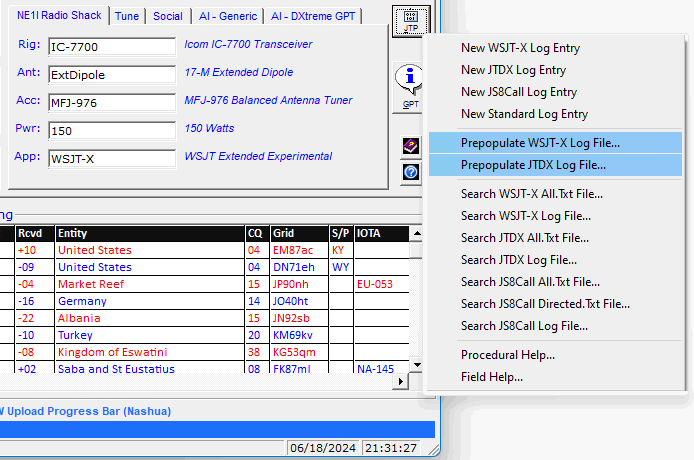
On the Set Criteria for ADIF Export window,
I click the desired Range of Bands and the
first JT Mode.
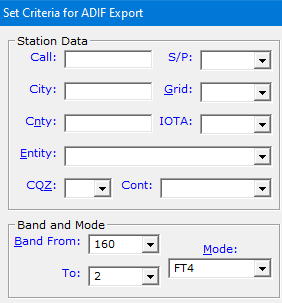
Then I click Run.

When prompted, on the Set Criteria for ADIF Export window,
I click the second JT Mode.
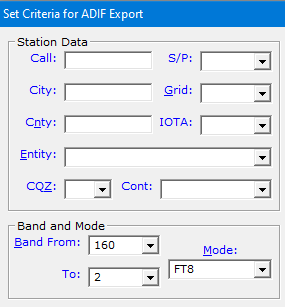
The Append to File box is selected automatically.
I click Run.

When prompted again, on the Set Criteria for ADIF Export window,
click the third JT Mode.
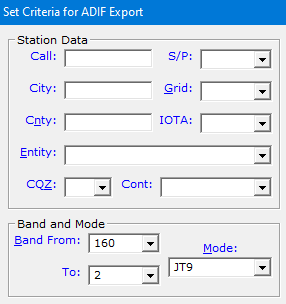
I click Run again. (I'm stopping at three JT modes, but I could continue
prepopulating with more modes if needed.)

WSJT-X {and JTDX} will import the prepopulated log file the
next time I restart them,
but here's the WSJT-X benefit:
It can
import its log file right away if I press F2
and click the Colors tab,
the Rescan ADIF Log button, and OK. Which I do.
A Little One-Time Configuration Work, Please
I'm almost ready to make and log contacts in the prepopulated
band range and JT modes on WSJT-X.
But because this is the first time I've prepopulated WSJT-X on this computer,
on its Settings window, I click the Reporting tab, select
Prompt me to log QSO, and click OK
to make the
WSJT-X Log QSO window appear automatically after each QSO.
Why, you ask?
Answer: For the creation of a preliminary, bare-bones log record
Station Log 15 will use for comprehensive logging.
{If this were the first time I prepopulated JTDX on this computer, on its Settings
window, I would click the
Reporting tab, select Enable automatic
logging of QSO, and click OK.
This is the benefit of using
JTDX: Creating the preliminary, bare-bones log record,
which Station Log 15 will use, is automatic, behind the scenes.
Its Log QSO window does not appear.}
Now I Can Operate
Using WSJT-X, I complete a QSO with K1BZM, who's operating from a semi-rare
VUCC grid I need on nearby Cape Cod: FN51!
(You know, there's always something interesting to work
during a VHF contest!)
The WSJT-X Log window appears and I immediately click its OK
button
without changing anything on the window. This action inserts the
preliminary, bare-bones log record into the
wsjtx_log.adi
file, which Station Log 15 will use shortly.
{If I were using JTDX, no Log window would appear because JTDX writes
the preliminary, bare-bones log record into the
wsjtx_log.adi
file immediately and automatically.
As stated earlier, this is the benefit of using
JTDX.}
Now I Log in DXtreme Station Log 15
I click the JT Processing button

Then I click New WSJT-X Log Entry {or New JTDX Log Entry}
on the shortcut menu
to pre-fill the
Station Log window with information from the preliminary, bare-bones log
record.
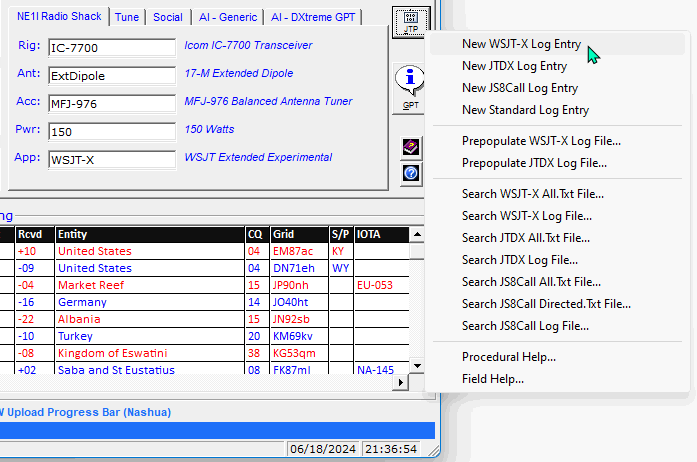
And then I finish the log entry by specifying as much, or as little, information
I want on the Station Log window before clicking OK.
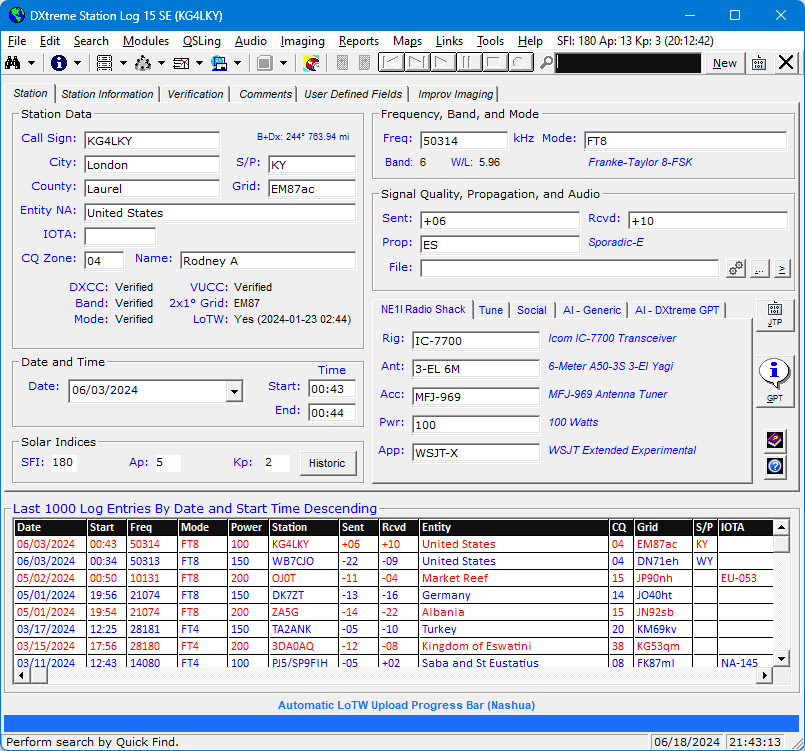
That's it. Contact information is in the Station Log database as well
as the appropriate
wsjtx_log.adi
file.
If I want to add more information later, I can always call up the log entry and
modify it.
Note
Only my most recent WSJT-X {or JTDX} contact can be logged
using this method. If desired, I can start a log entry, begin a
contact with another station, and finish logging the
previous contact before the new QSO ends.
For rapid-fire and contest operations, though,
I log in WSJT-X {or JTDX} only; and after I've finished operating,
I use Station Log's Import ADIF Utility to import the JT log entries into
Station Log's database.
The Station Log 15 Help System explains
how to do this.
1 — WSJT-X ©2001-2021 by Joe Taylor, K1JT
2 — JTDX by HF community © Igor UA3DJY and Arvo Järve ES1JA.
Home |
Checking DX Spots |
Adding the Log Entry and Automatically Uploading to LoTW |
Using JT Log Entry Processing
Using the Outgoing QSL Web Service |
Creating QSL and Address Labels |
Printing QSL and Address Labels |
Capturing an Improv Image
Managing Paper QSLs |
Managing LoTW QSLs |
Monitoring Performance |
Analyzing Your DXCC Status |
Other Fine Features |
Implementation and More
Click Here to Return Home